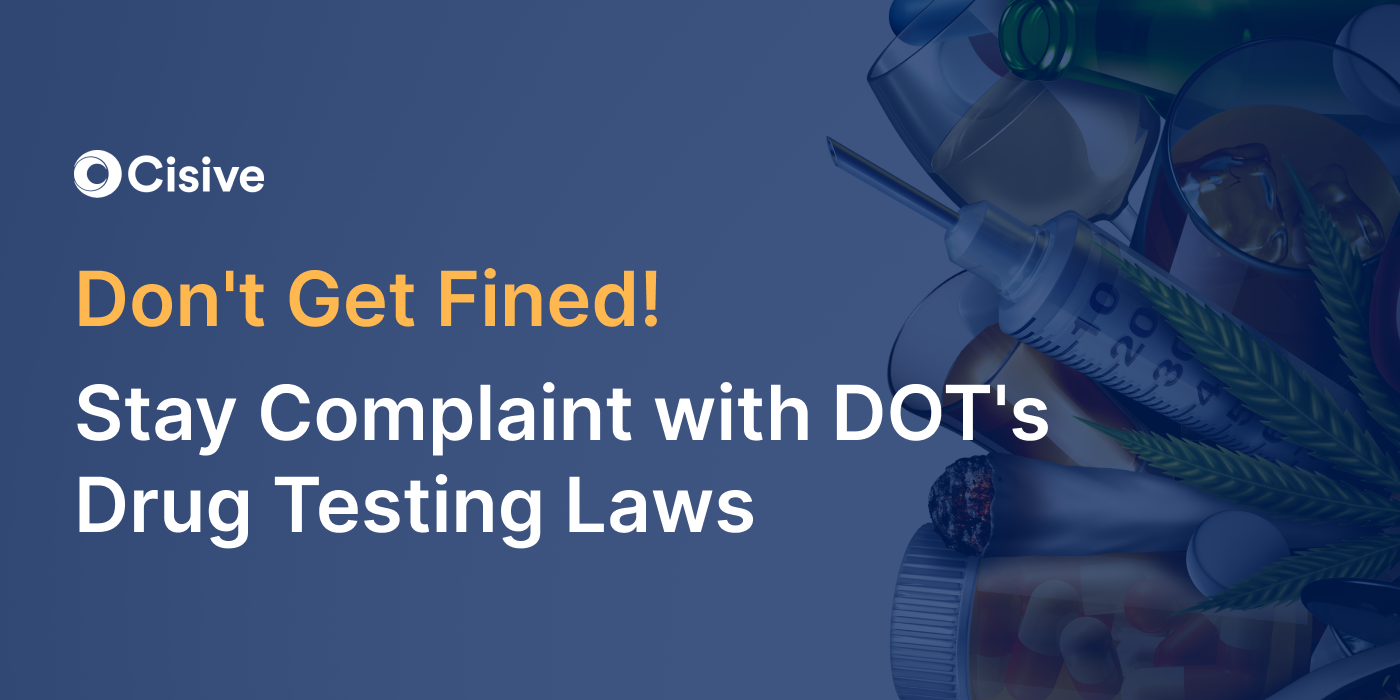

The Department of Transportation (DOT) issued its Final Rule amending federal drug testing...

The Department of Transportation (DOT) has hundreds of regulations designed to keep motorists, pedestrians, and cyclists safe from harm. If you work in the transportation industry, DOT’s preemployment drug testing regulations should be one of your top priorities.
We created this guide to help you understand why it’s so important to conduct DOT drug tests for preemployment.
To comply with the DOT regulations, a preemployment drug test must screen for marijuana, cocaine, opioids, amphetamines (methamphetamines and MDMA), and phencyclidine (PCP). The opioid category includes the following:
The initial urine drug screen is important for several reasons. First, it helps you make better hiring decisions.
If a candidate has a positive result, you can quickly eliminate them from your list of potential hires, which may reduce the risk of job-related accidents. Eliminating unsuitable candidates also helps you avoid hiring someone only to have to terminate their employment a few weeks or months later.
Second, urine drug screening helps you comply with DOT regulations. Under these regulations, every covered employer must implement a drug and alcohol testing program and wait until receiving the results of a test before allowing a new employee to perform safety-sensitive job duties.
Finally, a DOT drug test for preemployment purposes helps you create a safer environment for employees, customers, and community members. Drug testing can’t prevent every accident, but it can help you avoid hiring drivers who might put other people at risk.
If you’re worried that a potential employee will dilute their urine sample or alter it in some way, you may be able to use oral fluid drug testing in the near future. In May 2023, the DOT amended its regulations to allow saliva testing in addition to urine testing.
Before you can use this type of testing, certified labs must update their equipment and policies. The Department of Health and Human Services (HHS) must certify at least two labs to conduct testing. One serves as a primary lab, and a second serves as a split speciman lab.
Note: Many trucking companies also utilize non-DOT hair follicle testing on top of the required DOT testing. While the hair follicle test isn’t reported to the DOT, trucking companies use it to eliminate applicants who aren’t identified through a DOT drug test and the Federal Motor Carrier Safety Administration Drug & Alcohol Clearinghouse.
Under the DOT testing regulations, you must test every employee who performs safety-sensitive duties related to transportation. If your company is a commercial motor carrier, that means you have to test every commercial driver’s license (CDL) holder.
Companies in the aviation industry must test all employees involved in flight operations, maintenance, and security screening. This includes flight attendants, aviation screeners, flight instructors, and certain air traffic controllers.
If you hire employees for a railroad, you must conduct a DOT drug test for preemployment on all candidates who would be subject to the Hours of Service laws. These laws protect railroad workers by limiting the number of hours worked each month and requiring employers to provide undisturbed rest periods.
Conductors, locomotive engineers, and signalers are just a few of the railroad employees subject to preemployment drug testing under the DOT regulations. If your company hires its own utility employees, they’re also subject to the testing requirements.
Pipeline companies fall under the DOT testing regulations because they transport crude oil and other materials using a network of transmission pipelines. If you handle HR for one of these companies, you must do transportation drug testing on employees involved in operation, emergency response, or maintenance functions.
Finally, if your company offers public transportation, you must implement a testing program and conduct preemployment drug screens on all personnel involved in safety-sensitive functions. This includes vehicle controllers, armed security personnel, revenue service vehicle mechanics, and CDL holders who operate nonrevenue service vehicles.
It may be tempting to hire someone without waiting for the results of transportation drug testing, but that’s a violation of DOT regulations. Therefore, it’s important to time each test carefully.
Generally, you should wait until you interview several candidates and have your ideal hire in mind. That way, you can test just one person at a time, limiting the overall cost of your drug testing program.
Once you send a candidate for a DOT drug test for preemployment, you must wait until you receive the final result before you allow them to perform any safety-sensitive functions. The result must come from the Medical Review Officer or Consortium/Third-Party Administrator.
Under the DOT regulations, you must also test employees at the following times:
Previously taken DOT drug tests can be used if an employee moves into a new role, provided those tests meet the requirements outlined in §382.301(b). You don’t have to administer a preemployment drug screen if a driver has participated in another DOT-compliant controlled substances testing program within the previous 30 days.
To meet the requirements for an exception under §382.301(b), the individual must have participated in random drug testing for the previous 12 months or had a test for controlled substances within the previous 6 months.
If the candidate doesn’t meet both requirements, you must conduct an FMCSA drug test or another DOT-compliant drug test before allowing them to perform safety-sensitive duties. For example, if the candidate only participated in random testing for 9 months before applying with your company, they wouldn’t meet the guidelines for an exception.
This area of the law is complex, so it’s important to assess each candidate carefully. If necessary, contact previous employers to find out more about their testing programs.
The good news about the testing requirements is that you don’t have to perform drug screens at your employment site. In fact, it’s better to use a facility that’s equipped to conduct DOT-compliant tests.
It’s also important to use certified laboratories to analyze each sample. In the United States, labs involved in DOT testing must be certified by the Department of Health and Human Services National Laboratory Certification Program.
If you plan to use a foreign lab, the lab must be approved by the Department of Transportation. Certified labs are responsible for receiving urine samples, testing them for drugs, and conducting validity testing to make sure a candidate hasn’t diluted or tampered with their sample.
Because the DOT regulations affect so many companies, several companies have nationwide collection sites. This makes it more convenient for employers to comply with the DOT regulations without having to use multiple facilities for drug testing services.
If someone fails a DOT drug test for preemployment, you must remove them from safety-sensitive duties immediately. This is why it’s important to wait for the final test result before onboarding a new employee.
Some companies hire new employees and allow them to start working before receiving their DOT drug test results. Although this is permitted—provided they’re not performing any safety-sensitive duties, of course—doing so can put you in a tough spot if their preemployment drug tests come back positive.
If you haven’t officially hired the individual yet, you can rescind their employment offer and move on to the next candidate. You can’t do that if you’ve already hired someone and allowed them to start working for you.
In that case, you must decide whether you want to terminate the employee or allow them to complete the return-to-duty process. This process includes the following steps:
The return-to-duty process ensures the safety of everyone traveling on public roads. Therefore, it’s an important component of the DOT testing regulations.
Skipping the DOT drug test comes with severe penalties. For example, if you’re regulated by the Federal Motor Carrier Safety Administration (FMCSA), you may be fined thousands of dollars for each violation.
The fine amount depends on several factors, such as the severity of the violation and your company’s history with DOT compliance. If the fine is high enough, your company may have difficulty continuing its normal operations, making it critical that you understand and comply with the DOT drug testing regulations.
Skipping the DOT drug test may also cause your company to fail its FMCSA safety audit. All motor carriers are required to go through this audit within the first 12 months of operations.
During an FMCSA safety audit, the auditor reviews your company’s records to make sure you have controls in place to comply with all relevant regulations. The following violations result in an immediate audit failure:
If you fail your safety audit, you must develop a corrective action plan and submit it to the FMCSA within a limited amount of time. This is a time-consuming process that takes you and your colleagues away from other duties, so it’s something to avoid at all costs.
Depending on which agency regulates your industry, failure to comply with the DOT testing guidelines may even result in the suspension or revocation of your company’s operating authority. Therefore, it’s important to understand the guidelines and follow them closely.
DOT compliance is no laughing matter, especially for the recruiting and safety professionals charged with implementing the guidelines. If you don’t comply with the drug testing regulations, your company may face steep fines, fail its FMCSA safety audit, or lose its ability to operate.
The good news is that you don’t have to do it alone. Our partners understand the DOT guidelines and know how to return employees to safety-sensitive duties following testing violations.
Cisive offers random testing, preemployment drug testing, DOT audit assistance, and other services to help you comply with all relevant guidelines. Speak with an expert to learn why we’re a trusted compliance solution for DOT regulations with an industry-leading 99.9994% accuracy rate!

The Department of Transportation (DOT) issued its Final Rule amending federal drug testing...

Each year the Department of Transportation (DOT) evaluates the rate of positive testing results for...

What is the FMCSA Drug & Alcohol Clearinghouse? We are now two years into the Federal Motor Carrier...